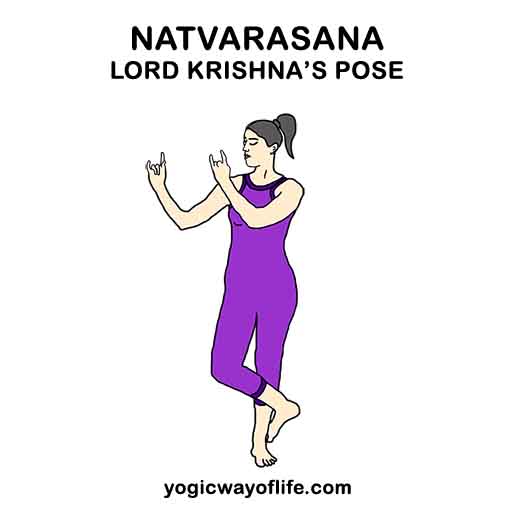Natvarasana or the Lord Krishna’s pose is a balancing pose that develops balance and concentration. In Sanskrit, Nata means dance and Asana means a yoga posture. Natvara is also a fond name of Lord Krishna. He is popularly depicted in this pose, playing the flute.
How to do Natvarasana (Lord Krishna’s Pose)
- Start in the standing position with feet together. Gaze at a point ahead of you steadily without straining.
- Bring the right leg forward and move it to the left in front of the left leg. Take it further and tuck the right foot behind the left calf muscles. Place the right foot straight and almost vertical behind the left leg. Tuck the right toes inside and behind the calf to maintain the balance.
- Keep the right calf muscles touching on the left leg shin for support.
- Raise both hands to the right, bend the elbows and place the palms as if you are playing the flute. Keep the index and little fingers of both hands straight. Curl the rest of the fingers. This pose must be familiar to all who have seen the picture or statue of Lord Krishna playing the flute in the standing position.
- Turn the head slightly to the left and gaze at a fixed point in front of you. As a variation, the head could even be turned even to the right slightly.
- Try to maintain the balance in this position. Breathe normally throughout the practice. Remain in this position for up to 2 minutes or as long as you are comfortable.
- To release the pose, turn the head back to the center, bring down both the arms to the side of the body and release the right leg and place it on the floor. Come back to the normal standing position.
- Repeat the same with the left foot tucked against the right leg with the hands positioned to the left and head turned slightly to the right.
You can do mutiple rounds of the practice if you desire.
Benefits of Natvarasana (Lord Krishna’s Pose)
- Natvarasana is a balancing pose. Practice this asana on both side to develop balance on both sides.
- Along with creating a sense of balance it increases concentration and awareness. During the practice, the mind should not wander. It improves steadiness and stability of the mind.
- Natvarasana can be used as a preparation for meditation.
Contraindications of Natvarasana
- Natvarasana a balancing pose. Those who are suffering from vertigo should not do this asana. The cerebellum, at the back of the brain controls the sense of balance. People with any damage to cerebellum should not attempt this pose.
- Those who suffer from weak heart or high blood pressure should avoid this pose.
- If you have any ankle injury, do not do this pose.

